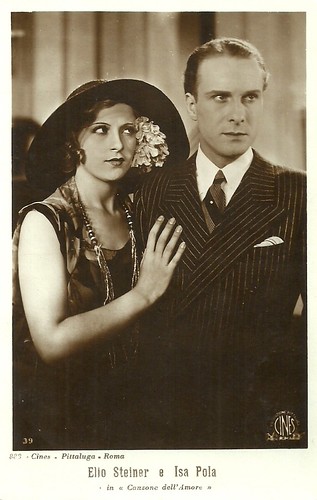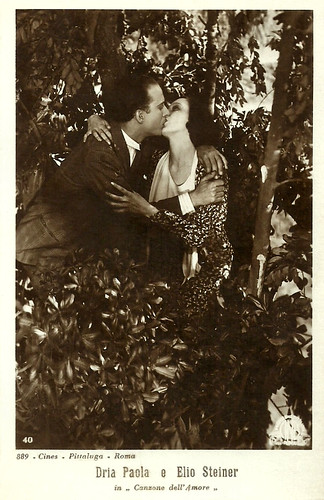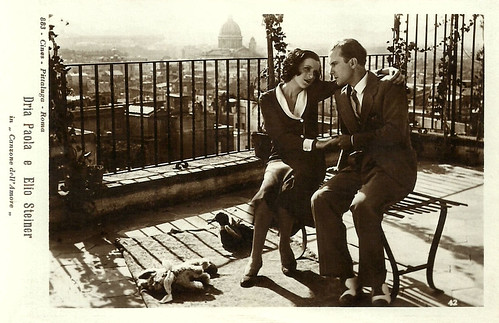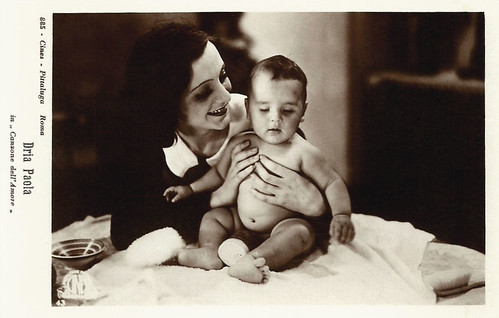
Italian postcard by G.B. Falci, Milano, no. 887. Photo: Cines Pittaluga, Roma, no. 38. Publicity still of Dria Paola in La canzone dell’amore (1930).
Quite Absurd Story
La canzone dell’amore/The Song of Love (Gennaro Righelli, 1930) was the first Italian sound feature - released in Italy and entirely produced in Italy. It was distributed by Societa Anonima Stefano Pittaluga and produced by Società Italiana Cines.
Alessandro Blasetti's Resurrectio/The Resurrection was in fact the first sound film produced in Italy, but it was only released in 1931. Allegedly because La canzone dell’amore was thought to be more commercial, and indeed, Resurrectio became a box-office flop.
The quite absurd story of La canzone dell’amore is about a young woman who adopts the baby her mother gave birth to. It was based very loosely on a short story by Luigi Pirandello, In silenzio (In Silence).
While her widowed mother dies giving birth, music student Lucia (Dria Paola) adopts little Ninni, pretending to her fiancé Enrico (Elio Steiner) and her landlady it is her own child.
Lucia breaks up her engagement with Enrico, who is about to become a big musician. Lucia’s rival Anna, played by another upcoming star: Isa Pola, gets hold of Enrico. But when Lucia and Enrico later on meet in the big record store where Lucia works and where Enrico is making a record, he admits he still loves her.
The father of the child (Camillo Pilotto) shows up and claims the child. Heartbroken, Lucia gives in but tries to commit suicide afterwards. Just in time Enrico saves her, the father gives the child to Lucia and all is well.

Italian postcard by G.B. Falci, Milano, no. 888. Photo: Cines Pittaluga, Roma, no. 39. Isa Pola and Elio Steiner in La canzone dell'amore (Gennaro Righelli, 1930).

Italian postcard by G.B. Falci, Milano, no. 889. Photo: Cines Pittaluga, Roma, no. 40. Lucia (Dria Paola) and Enrico (Elio Steiner) hide from their friends in order to be able to kiss each other, in La canzone dell’amore (1930).
Double Framing
La canzone dell’amore opens and closes with images of Rome, and is actually one of the few Italian films from the 1930s showing the city repeatedly.
Stylistically important are the different moments of double framing, when Lucia looks out from her rented rooms and mimics neighbours how to change diapers and feed the child. Interesting is also Righelli’s visualisation of Lucia’s frenzy at her suicide attempt and his pans across the enormous set of the record store.
La canzone dell’amore had its premiere on 7 October 1930 at the Supercinema in Rome, the actual Teatro Nazionale. The film was a popular success, not in the least because of the music composed by Cesare Andrea Bixio, whose well-known song Solo per te Lucia became a hit as well.
Gerald A. DeLuca at IMDb: "Although laced with elements of soap opera, the film is nicely acted and manages to engross the viewer so that one really cares about what happens to this poor woman and her 'son' that she has grown to love. The boy, at the age of 14 months, is played by this sweetheart of a kid named Nello Rocchi. The film has some genuinely touching moments. My favorite one is when Lucia is at a loss about how to change and diaper the child on her first day with him. She looks out the apartment window across the way at another mom who is bathing, changing, and nursing her own child. Lucia imitates what the other mother is doing as though the neighbor were providing how-to instructions in motherhood. The only thing she cannot imitate is the breast-feeding; Lucia ponders the difference between herself and her neighbor, then grabs the baby-bottle to feed little Ninní. All this is accompanied by a lovely ninna-nanna in the background."
The film also had two alternate-language versions, one in German, Liebes Lied (Constantin J. Davis, 1931) starring Gustav Fröhlich and Renate Müller, and one in French, La dernière berceuse (Jean Cassagne, 1931) with Jean Angelo and Dolly Davis.
Lead actress Dria Paola became a star overnight. But soon the thin actress with the big head and fluttering hands was type casted as the fragile and sometimes clumsy damsel in distress. She could never repeat the success of her first sound film, and retired in the 1940s.

Italian postcard by G.B. Falci, Milano, no. 883. Photo: Cines Pittaluga, Roma, no. 40. After an attempted suicide, Lucia (Dria Paola) and Enrico (Elio Steiner) make up towards the end of La canzone dell’amore (1930). The cityscape of Rome in the background.

Italian postcard by G.B. Falci, Milano, no. 885. Photo: Cines Pittaluga, Roma, no. 43. Publicity still of Dria Paola in La canzone dell’amore (1930).
Sources: Wikipedia (Italian), and IMDb.
No comments:
Post a Comment